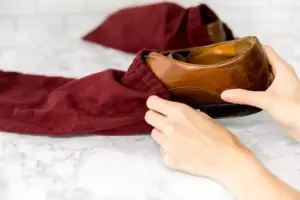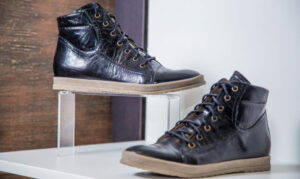How well does super glue work on leather?
Super glue is a common adhesive that is often used for many quick household repairs due to its strong adhesive properties. But does super glue work on leather?
How effective and safe is it to use on leather crafts?
In this article, we’ll answer this question by looking at whether or not super glue can be used to repair leather items. We’ll also discuss the pros and cons of using super glue such as Loctite and Gorilla glue on leather and provide you with tips to use it safely.

Does super glue work on leather?
Yes, super glue does work on leather, and it’s effective for fixing small tears, cuts, and worn-out seams in leather items like shoes, bags, and jackets. However, super glue might not be the best option for all types of leather goods because it creates a bond that is not flexible enough to withstand movement, which leads to the cracking and peeling of leather.
So while super glue can provide a quick and easy solution for repairing leather goods, it has its cons.
Before you start your repair, be wary of the falling drawbacks of using super glue.
1. Super glue is not flexible
Leather items like shoes and jackets need to be flexible. However, super glue tends to create a very strong and rigid bond which may not be able to handle the bending and flexing that such leather items undergo during regular use.
This affects the integrity of the repair and even makes the damage to the leather item worse.
Thus, if you want to use super glue to fix your leather item, consider the area being repaired and the amount of movement it will undergo.
For instance, if the repair is on a portion of leather that experiences a lot of movement or flexing such as the crease in a leather shoe or at the knees of a pair of leather pants, using super glue may not be a good option as it can cause cracking over time and worsen the damage.
2. It can discolor leather
Another negative effect you might experience is the discoloration of your leather item.
This often occurs when you use too much super glue causing the leather to become over-saturated.
Since leather is a porous material, the excess glue can penetrate deep into the leather pore and cause it to discolor. This often leaves a noticeable stain that can be very difficult to remove.
To prevent this, you are advised to apply a thin and even layer of super glue when doing any repair on leather.
This will help to prevent over-saturation and ultimately reduce the risk of discoloration.
3. Super glue is difficult to remove
If you make a mistake when repairing your leather item with super glue, the bond created is so strong that it is nearly impossible to remove without damaging the leather.
The reason for this is that once super glue is applied and cured, the strong and rigid bond it forms cannot be broken easily.
When this happens, you might need to use solvents or remove the super glue or certain specialized glue removal products. The downside to this is that some of these products can cause damage to the leather if not used properly.
How to use super glue on leather effectively
Despite the above drawbacks, you can still use super glue to do certain minor repairs on leather by following these steps.
Step 1: Clean your leather item
The first step is to clean your leather item, which could be shoes, bags, purses, jackets, or leather pants.
Dirt, grease, dust, and oils can interfere with the adhesive’s ability to stick to the leather. So, cleaning the leather surface first will help the glue to adhere strongly and create a long-lasting bond.
You can use rubbing alcohol to remove grease and oil or a damp cloth and mild soap to clean dust and dirt from the leather surface to be repaired.
Step 2: Apply the super glue
Once the leather dries, the next step is to apply the super glue.
There are many different types of super glue that you can choose for your leather repairs. Cyanoacrylate-based super glue is usually a good choice since it forms a strong and flexible bond with leather.
Some popular cyanoacrylate-based super glue that is available in flexible formulas include Gorilla Super Glue and Loctite Ultra Gel Control super glue.
When selecting a suitable glue for leather, choose one that is specifically made for use on porous surfaces because some types of super glue do not stick well to leather.
In regards to the application process, avoid applying too much super glue as this can cause a mess and make the damage worse.
Step 3: Wipe off excess super glue
In case you have accidentally applied too much glue and created a mess outside the bond area, use a solvent to wipe it off.
Some common solvents that you can use include pure acetone, rubbing alcohol, or a specialized glue-removal product.
As always, test the solvent on an inconspicuous part of your leather item first to ensure that it doesn’t cause discoloration or other adverse effects.
Apply the solvent to a soft cloth and rub it gently on the super glue until it starts to loosen and then scrape off with a blunt-edged tool or plastic scraper carefully without damaging the leather.
Conclusion
Super glue does work quite well on leather in some situations such as minor or small repairs.
However, it is important to weigh the benefits and the drawbacks before making a decision.
Super glue forms a hard and rigid bond that may not be flexible enough for some of your leather items. The bond may cray or peel over if applied to leather items that are subjected to a lot of movement or wear.
Additionally, superglue can cause discoloration on leather and it can be difficult to remove once cured.
So for effective application, follow the steps we have outlined above to ensure the bond is effective and will not cause further damage to your leather item.



